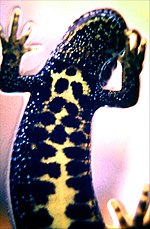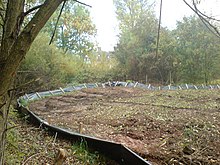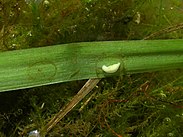Northern crested newt
| Northern crested newt | |
|---|---|

| |
| Male during breeding season | |
| Scientific classification | |
| Domain: | Eukaryota |
| Kingdom: | Animalia |
| Phylum: | Chordata |
| Class: | Amphibia |
| Order: | Urodela |
| Family: | Salamandridae |
| Genus: | Triturus |
| Species: | T. cristatus
|
| Binomial name | |
| Triturus cristatus (
Laurenti , 1768) | |

| |
| Synonyms | |
|
Over 40,[2] including:
| |
The northern crested newt, great crested newt or warty newt (Triturus cristatus) is a newt species native to Great Britain, northern and central continental Europe and parts of Western Siberia. It is a large newt, with females growing up to 16 cm (6.3 in) long. Its back and sides are dark brown, while the belly is yellow to orange with dark blotches. Males develop a conspicuous jagged crest on their back and tail during the breeding season.
The northern crested newt spends most of the year on land, mainly in forested areas in lowlands. It moves to aquatic breeding sites, mainly larger fish-free
Several of the northern crested newt's former subspecies are now recognised as separate species in the genus
While the
Taxonomy
The northern crested newt was described as Triton cristatus by Josephus Nicolaus Laurenti in 1768.[2] As Linnaeus had already used the name Triton for a genus of sea snails ten years before,[3] Constantine Samuel Rafinesque introduced the new genus name Triturus in 1815, with T. cristatus as type species.[4]
Over 40 scientific names introduced over time are now considered as synonyms, including Lacertus aquatilis, a nomen oblitum published four years before Laurenti's species name.[2] Hybrids resulting from the cross of a crested newt male with a marbled newt (Triturus marmoratus) female were mistakenly described as distinct species Triton blasii, and the reverse hybrids as Triton trouessarti.[2][5]
T. cristatus was long considered as a single species, the "crested newt", with several subspecies. Substantial genetic differences between these subspecies were, however, noted and eventually led to their recognition as full species, often collectively referred to as "T. cristatus species complex". There are now seven accepted species of crested newts, of which the northern crested newt is the most widespread.[6]
Description


The northern crested newt is a relatively large newt species. Males usually reach 13.5 cm (5.3 in) total length, while females grow up to 16 cm (6.3 in). Rare individuals of 20 cm (7.9 in) have been recorded. Other crested newt species are more stockily built; only the
The newts have rough skin, and are dark brown on the back and sides, with black spots and heavy white stippling on the flanks. The female has a yellow line running along the lower tail edge. The throat is mixed yellow–black with fine white stippling, the belly yellow to orange with dark, irregular blotches.[7]: 342
During the aquatic breeding season, males develop crest up to 1.5 cm (0.59 in) high, which runs along the back and tail but is interrupted at the tail base. It is heavily indented on the back but smoother on the tail. Also during breeding season, the male's cloaca swells and it has a blue–white flash running along the sides of the tail. Females do not develop a crest.[7]: 342 [8]: 12–15
Range
The northern crested newt is the most widespread and northerly crested newt species. The northern edge of its range runs from Great Britain through southern Fennoscandia to the Republic of Karelia in Russia; the southern margin runs through central France, southwest Romania, Moldavia and Ukraine, heading from there into central Russia and through the Ural Mountains. The eastern extent of the great crested newt's range reaches into Western Siberia, running from the Perm Krai to the Kurgan Oblast.[10]
In western France, the species co-occurs and sometimes hybridises (see section Evolution below) with the marbled newt (Triturus marmoratus).
Habitat

Outside of the breeding season, northern crested newts are mainly
Preferred aquatic breeding sites are stagnant, mid- to large-sized, unshaded water bodies with abundant
The northern crested newt is generally a lowland species but has been found up to 1,750 m (5,740 ft) in the Alps.[7]: 343 [1]
Population structure, speciation, and phylogeny
Hybridization
In certain areas of France, the northern crested newt and the marbled newt overlap, and hybrids are present. As the northern crested newt's population grows, and marbled newt population struggles, these hybrids have been shown to possess good qualities of both. They have more fecundity than the two newts however have a hard time keeping their eggs alive.[13]
Life cycle and behaviour
Like other newts, T. cristatus develops in the water as a larva and returns to the water each year for breeding. Adults spend around seven months of the year on land. After larval development in the first year, juveniles pass another year or two before reaching maturity; in the north and at higher elevations, this can take longer. The larval and juvenile stages are the riskiest for the newts, while survival is higher in adults. Once the risky stages passed, adult newts usually have a lifespan of seven to nine years, although individuals have reached 17 years in the wild.[8]: 98–99
Adult newts begin moving to their breeding sites in spring when temperatures stay above 4–5 °C (39–41 °F), usually in March.[8]: 44 In the aquatic phase, crested newts are mostly nocturnal and, compared to smaller newt species, usually prefer the deeper parts of a water body, where they hide under vegetation. As with other newts, they have to occasionally move to the surface to breathe air. The aquatic phase serves not only for reproduction, but also offers more abundant prey, and immature crested newts frequently return to the water in spring even if they do not breed.[8]: 52–58
During the terrestrial phase, the newts use hiding places such as logs, bark, planks, stone walls, or small mammal burrows; several individuals may occupy such refuges at the same time. Since the newts generally stay very close to their aquatic breeding sites, the quality of the surrounding terrestrial habitat largely determines whether an otherwise suitable water body will be colonised.[8]: 47–48,76 [12][14] Great crested newts may also climb vegetation during their terrestrial phase, although the exact function of this behaviour is not known at present.[15]
The juvenile
Diet and predators
Northern crested newts feed mainly on invertebrates. During the land phase, prey include
The larvae are themselves eaten by various animals such as carnivorous invertebrates and
Courtship and reproduction
Northern crested newts, like their relatives in the genus Triturus, perform a complex
The eggs are fertilised internally, and the female deposits them individually, usually folding them into leaves of aquatic plants. A female takes around five minutes for the deposition of one egg. They usually lay around 200 eggs per season. Embryos are usually light-coloured, 1.8–2 mm in diameter with a 6 mm jelly capsule, which distinguishes them from eggs of other co-existing newt species that are smaller and darker-coloured. A genetic particularity shared with other Triturus species causes 50% of the embryos to die.[8]: 61–62 [18]
Larvae hatch after two to five weeks, depending on temperature. As in all salamanders and newts, forelimbs develop first, followed later by the back legs. Unlike smaller newts, crested newt larvae are mostly
Evolution
The northern crested newt sometimes hybridises with other crested newt species where their ranges meet, but overall, the different species are
In western France, the northern crested newt's range overlaps with that of the marbled newt (T. marmoratus), but the two species in general prefer different habitats.[21][22] When they do occur in the same breeding ponds, they can form hybrids, which have intermediate characteristics. Hybrids resulting from the cross of a crested newt male with a marbled newt female are much rarer due to increased mortality of the larvae and consist only of males. In the reverse cross, males have lower survival rates than females. Overall, viability is reduced in these hybrids and they rarely backcross with their parent species. Hybrids made up 3–7% of the adult populations in different studies.[5]
Little
Threats and conservation

The northern crested newt is listed as species of
The major reason for decline is
The northern crested newt is listed in
Preservation of natural water bodies, reduction of fertiliser and pesticide use, control or eradication of introduced predatory fish, and the connection of habitats through sufficiently wide corridors of uncultivated land are seen as effective conservation actions. A network of aquatic habitats in proximity is important to sustain populations, and the creation of new breeding ponds is in general very effective as they are rapidly colonised when other habitats are nearby. In some cases, entire populations have been moved when threatened by development projects, but such translocations need to be carefully planned to be successful.[8]: 118–133 [12]
Strict protection of the northern crested newt in the United Kingdom has created conflicts with local development projects, but the species is also seen as a flagship species, whose conservation also benefits a range of other amphibians.[12] Government agencies have issued specific guidelines for the mitigation of development impacts.[30]
References
- ^ .
- ^ a b c d Frost, D.R. (2020). "Triturus cristatus (Laurenti, 1768). Amphibian Species of the World 6.0, an Online Reference". New York: American Museum of Natural History. Retrieved 2020-05-03.
- ^ Linnaeus, C. (1758). Systema naturæ per regna tria naturæ, secundum classes, ordines, genera, species, cum characteribus, differentiis, synonymis, locis. Editio decima, reformata (in Latin). Holmiae: Salvius. p. 658.
- ^ Rafinesque C.S. (1815). Analyse de la nature ou Tableau de l'univers et des corps organisés (in French). Palermo: Jean Barravecchia. p. 78.
- ^ S2CID 12083435.
- ^ Frost, D.R. (2020). "Triturus Rafinesque, 1815. Amphibian Species of the World 6.0, an Online Reference". New York: American Museum of Natural History. Retrieved 2020-04-22.
- ^ ISBN 9789004285620.
- ^ ISBN 978-3-933066-44-2.
- ^ PMID 30630099.
- ^ a b Kuzmin, S. (1999). "AmphibiaWeb – Triturus cristatus". University of California, Berkeley. Archived from the original on 2016-04-11. Retrieved 2020-05-10.
- ^ ISSN 0024-4066.
- ^ a b c d e f g h i j k l m Edgar, P.; Bird, D.R. (2006). Action plan for the conservation of the crested newt Triturus cristatus species complex in Europe (PDF). Convention on the conservation of European wildlife and natural habitats Standing Committee 26th meeting. Strasbourg: Council of Europe. Archived from the original (PDF) on 2016-08-02.
- ISSN 0906-7590.
- ^ Jehle, R. (2000). "The terrestrial summer habitat of radio-tracked great crested newts (Triturus cristatus) and marbled newts (T. marmoratus)". The Herpetological Journal. 10: 137–143.
- S2CID 249300071.
- ^ "AmphibiaWeb - Triturus cristatus".
- PMID 5938783.
- JSTOR 1564180.
- ^ ISSN 0006-3207.
- PMID 21672214.
- ISBN 2-85653-574-7.
- ISSN 0173-5373.
- S2CID 24530095.
- ISSN 0024-4066.
- ISSN 0024-4066.
- S2CID 207041490.
- PMID 25359973.
- ^ a b "Convention on the Conservation of European Wildlife and Natural Habitats". Bern: Council of Europe. 1979. Retrieved 2015-05-24.
- ^ a b "Council directive 92/43/EEC on the conservation of natural habitats and of wild fauna and flora". Act No. 1992L0043 of 1 January 2007. Retrieved 2015-05-31.
- ISBN 1-85716-568-3. Archived from the original(PDF) on 2008-06-20.







